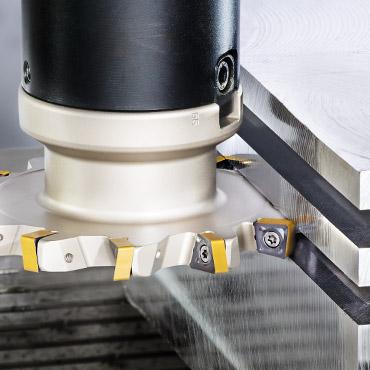
HELISLOT is a family of full slot milling cutters with square inserts that provide an effective and economical solution for machining slots and grooves. These cutters carry XNMU … inserts with a unique configuration.
The robust square double-sided insert features 8 (4 right-hand and 4 left-hand) helical cutting edges and a unique twisted upper and bottom surface. The inserts, when clamped on the insert’s staggered teeth formation with alternating axial rakes, contribute to very stable cutting even under high chip loads. The twisted positive rakes create a smooth cutting action.
Due to the staggered teeth formation, positive rake, and rigid insert clamping the cutters assure high performance, reliability, and productivity.
The unique XNMU .. inserts are the original concept of double-sided inserts with 4 right-hand and 4 left-hand helical cutting edges for slot milling cutters. These inserts are made of SUMOTEC carbide grades, designed for milling alloy steel, ferritic and martensitic stainless steel, and cast-iron.
Features:
- Durable insert with 8 cutting edges.
- Staggered teeth with positive rakes.
- Rigid insert clamping.
- Bent shaped and quad hole for accurate positioning.
Advantages:
- Cost-effective.
- High productivity.
- Easy and smooth cutting.
Diameter range:
ETS
Metric: 40-48 mm
Imperial: 1.46 "
SDN
Metric: 100-200 mm
Imperial: 4.0-8.0"
FDN
Metric: 100-200 mm
Imperial: 4.0-8.0"
Insert size: 13 mm
Insert geometry:
- XNMU 130608PNN-MM
- XNMU 130608PNTN
- XNMU 130608PNN-PL
Grades
- IC808
- IC830
- IC330
- IC5400
- IC845
- IC810
- IC5100
Contact Details
Related Glossary Terms
- gang cutting ( milling)
gang cutting ( milling)
Machining with several cutters mounted on a single arbor, generally for simultaneous cutting.
- milling
milling
Machining operation in which metal or other material is removed by applying power to a rotating cutter. In vertical milling, the cutting tool is mounted vertically on the spindle. In horizontal milling, the cutting tool is mounted horizontally, either directly on the spindle or on an arbor. Horizontal milling is further broken down into conventional milling, where the cutter rotates opposite the direction of feed, or “up” into the workpiece; and climb milling, where the cutter rotates in the direction of feed, or “down” into the workpiece. Milling operations include plane or surface milling, endmilling, facemilling, angle milling, form milling and profiling.
- rake
rake
Angle of inclination between the face of the cutting tool and the workpiece. If the face of the tool lies in a plane through the axis of the workpiece, the tool is said to have a neutral, or zero, rake. If the inclination of the tool face makes the cutting edge more acute than when the rake angle is zero, the rake is positive. If the inclination of the tool face makes the cutting edge less acute or more blunt than when the rake angle is zero, the rake is negative.









